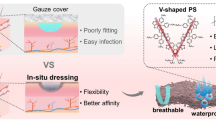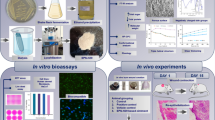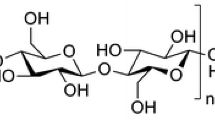Abstract
This article presents the experimental data on the testing of new wound dressings, viz., porous plates, prepared on the basis of chitosan and calcium alginate that contain biologically active substances (BASs) derived from marine hydrobionts. In a burn wound model in guinea pigs, we revealed a positive effect of tested samples of wound dressings on the wound-healing process; the data of planimetric and pathomorphological studies showing the acceleration of the process of regeneration in the wound are discussed. It was noted that the dynamics and patomorphological characteristics of the wound healing process differed depending on the structure of the BAS included into the composition of wound dressings (peptides, sulfated polysaccharides, a complex of amino acids and peptides).
Similar content being viewed by others
References
Andreev, D.Yu., Paramonov, D.A., and Mukhtarova, A.M., Modern wound dressings, Part 1, Vestn. Khir. im. I. I. Grekova, 2009, vol. 168, no. 3, pp. 98–102.
Besednova, N.N. and Epstein, L.M., Immunoaktivnye peptidy iz gidrobiontov i nazemnykh zhivotnykh (Immunoactive Peptides from Hydrobiontes and Terrestrial Animals), Vladivostok: Tikhookean. Nauchno-Issled. Inst. Rybn. Khoz. Okeanogr., 2004.
Bobiev, G.M., Bunyatyan, N.D., Sayadyan, Kh.S., and Sapovskii, M.M., Immunoaktivnye peptidy i ikh koordinatsionnye soedineniya v meditsine (Immunoactive Peptides and Their Coordination Compounds in Medicine), Moscow: Russkii Vrach, 2009.
Vlasov, A.A., Biodegradable wound dressings based on polysaccharide polymers (experimental research), Vopr. Rekonstr. Plast. Khir., 2011, no. 2, pp. 53–65.
Gritsyuk, N.A., Zaporozhets, T.S., Besednova, N.N., et al., Biologicheski aktivnaya dobavka tinrostim v profilaktike i kompleksnom lechenii posoperatsionnykh oslozhnenii v onkoginekologii. Metodicheskie rekommendatsii utverzhdennye nachal’nikom Departamenta zdravookhraneniya Administratsii Primorskogo kraya (Biologically Active Food Additive Tinrostim in Prevention and Complex Treatment of Postoperative Complications in Gynecological Oncology. Methodological Recommendations Approved by the Head of the Department of Health Administration of Primorsky Krai), Vladivostok, 2004.
Davidovich, V.V., Pivnenko, T.N., Ayushin, N.B., and Yur’eva, M.I., Evaluation of antioxidant activity: BAA “Molluskam”, Izv. Tikhookean. Nauchno-Issled. Inst. Rybn. Khoz. Okeanogr., 2006, vol. 145, pp. 338–347.
Kuznetsova, T.A., Besednova, N.N., Kovalev, N.N., et al., RF Patent 2545893, 2015.
Petrov, S.V., Obshchaya Khiirurgiya (General Surgery), 3rd ed., Moscow: GEOTAR-Media, 2010.
Sevastyanov, V.I., Biomaterials, drug delivery systems and bioengineering, Vestn. Transplantologii Iskusstv. Organov, 2009, vol. 11, no. 3, pp. 14–24.
Khotimchenko, M.Yu., Farmakonutritsiologiya alginatov (Pharmaconutritionology of alginates), Vladivostok: Dalnauka, 2009.
Shablin, D.V., Pavlenko S.G., Evglevsky, A.A., et al., Modern wound dressings in the local treatment of wounds of various genesis, Fundam. Issled., 2013, no. 12, pp. 361–366.
Yakushin, S.V., Usov, V.V., Polezhaev, A.A., and Bolokhova, I.L., Effect of topical application of immunomodulator and antioxidant for a wound healing process, Sovrem. Probl. Nauki Obraz., 2012, no. 6, pp. 16–21.
Alsarra, I.A., Chitosan topical gel formulation in the management of burn wounds, Int. J. Biol. Macromol., 2009, vol. 45, pp. 16–21.
Draget, K.I. and Taylor, C., Chemical,physical and biological properties of alginates and their biomedical implications, Food Hydrocolloids, 2011, vol. 25, pp. 251–256.
European Convention for the Protection of Vertebrate Animals Used for Experimental and Other Scientific Purposes, ETS, no. 123, Strasbourg, 18.03.1986.
George, M. and Abraham, T.E., Polyionic hydrocolloids for the intestinal delivery of protein drugs: alginate and chitosan—a review, J. Controlled. Release, 2006, vol. 114, pp. 1–14.
Jayakumar, R., Prabaharan, M., Sudheesh Kumar, P.T., et al., Novel chitin and chitosan materials in wound dressing, Biomed. Eng., Trends Mater. Sci., 2011.
Jiao G., Yu, G., Zhang, J., and Ewart, H., Chemical structures and bioactivities of sulfated polysaccharides from marine algae, Mar. Drugs., 2011, vol. 9, pp. 196–223.
Murakami, K., Aoki, H., Nakamura, S., et al., Hydrogel blends of chitin/chitosan, fucoidan and alginate as healing-impaired wound dressings, Biomaterials, 2010, vol. 31, pp. 83–90.
O’Leary, R., Rerek, M., and Wood, E.J., Fucoidan modulates the effect of transforming growth factor (TGF)-ß1 on fibroblast proliferation and wound repopulation in vitro models of dermal wound repair, Biol. Pharm. Bull., 2004, vol. 27, pp. 266–270.
Sezer, A., Hatipoglu, F., Cevher, E., et al., Chitosan film containing fucoidan as a wound dressing for dermal burn healing: preparation and in vitro/in vivo evaluation, AAPS PharmSciTech., 2007, vol. 8, pp. 94–101.
Wijesekara, I., Pangestuti, R., and Kim, S., Biological activities and potential health benefits of sulfated polysaccharides derived from marine algae, Carbohydr. Polym., 2011, vol. 84, pp. 14–21.
Author information
Authors and Affiliations
Corresponding author
Additional information
Original Russian Text © T.A. Kuznetsova, N.N. Besednova, N.N. Kovalev, L.M. Somova, V.V. Usov, I.D. Makarenkova, N.G. Plekhova, E.I. Drobot, 2016, published in Biologiya Morya.
Rights and permissions
About this article
Cite this article
Kuznetsova, T.A., Besednova, N.N., Kovalev, N.N. et al. Experimental evaluation of the effectiveness of wound dressings based on biologically active substances from marine hydrobionts. Russ J Mar Biol 42, 427–432 (2016). https://doi.org/10.1134/S1063074016050059
Received:
Published:
Issue Date:
DOI: https://doi.org/10.1134/S1063074016050059




